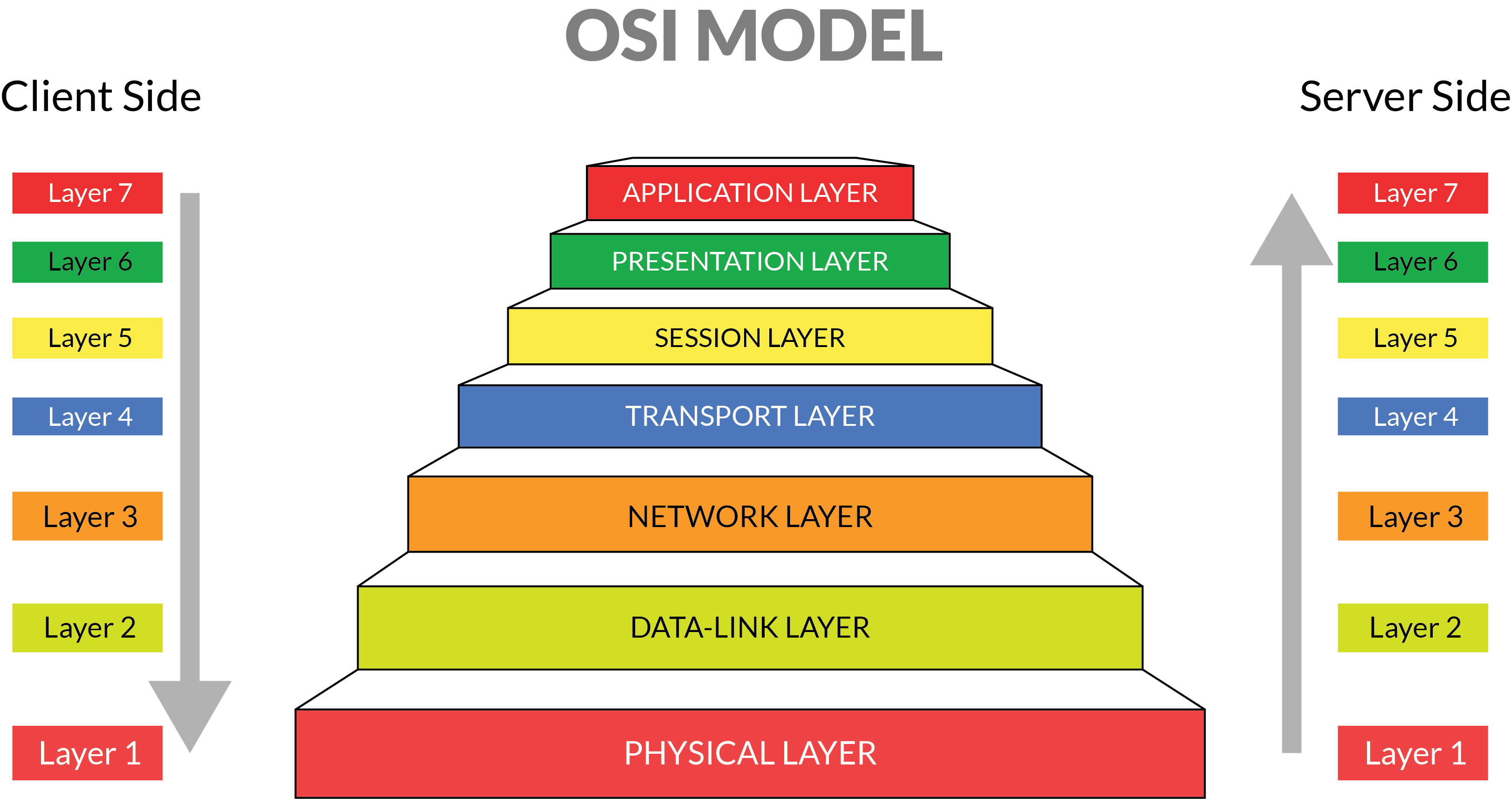Exploring the Complexity: Understanding the OSI Model
The OSI (Open Systems Interconnection) model is a framework that standardizes how different systems communicate over a network. It is divided into seven layers, each responsible for a specific aspect of the communication process. Understanding the OSI model can help network administrators troubleshoot issues, optimize network performance, and ensure compatibility between different devices and networks.
What is the OSI Model and Why is it Important?
The OSI (Open Systems Interconnection) model is a conceptual framework that standardizes the functions of a telecommunication or computing system into seven different layers. These layers work together to facilitate communication between different devices on a network.
The OSI model is important because it provides a clear and logical way to understand how different network protocols and technologies interact with each other. By breaking down the communication process into distinct layers, network engineers and administrators can troubleshoot network issues more efficiently and effectively. Additionally, the OSI model serves as a foundation for developing new networking protocols, standards, and technologies.
Overall, the OSI model is a fundamental tool that helps ensure interoperability, scalability, and efficiency in computer networks. It provides a common language for network professionals to discuss and implement network solutions.
Introduction to the OSI Model
The OSI model, or Open Systems Interconnection model, is a conceptual framework used to understand how different networking protocols and systems interact with each other. It breaks down the process of network communication into seven distinct layers, each with its own specific functions and responsibilities. By defining these layers, the OSI model helps network engineers and administrators understand how different components of a network work together to facilitate communication between devices.
Significance of OSI Model in Networking
The OSI (Open Systems Interconnection) model is a conceptual framework that standardizes the functions of a telecommunication or computing system into seven distinct layers. Each layer serves a specific purpose and interacts with the layers above and below it to facilitate communication between devices on a network.
The significance of the OSI model in networking includes:
1. Standardization:
The OSI model provides a common language and framework for understanding and discussing network functions and protocols. It allows different vendors and developers to create interoperable networking products.
2. Layered Approach:
The seven layers of the OSI model break down complex networking tasks into smaller, more manageable components. This allows for easier troubleshooting, maintenance, and development of network infrastructure.
3. Interoperability:
By defining standard protocols and functions for each layer, the OSI model ensures that devices from different manufacturers can communicate with each other. This is essential for building large, heterogeneous networks.
4. Scalability:
The modular design of the OSI model makes it easier to scale a network up or down by adding or removing layers as needed. This flexibility allows for efficient growth and optimization of network resources.
5. Troubleshooting:
The layered approach of the OSI model facilitates troubleshooting by isolating network issues to a specific layer. This makes it easier to pinpoint and resolve problems in the network.
6. Education and Training:
The OSI model is commonly used in networking education and training programs to teach students about the different functions and protocols involved in networking. It provides a structured framework for understanding complex networking concepts.
Overall, the OSI model plays a crucial role in the design, implementation, and management of networking systems by providing a standardized, modular approach to communication and data exchange.
Overview of the 7 Layers
The OSI (Open Systems Interconnection) model is a conceptual framework that standardizes the functions of a telecommunication or computing system into seven distinct layers. Each layer in the model serves a specific purpose and helps to ensure that communication between devices is efficient, reliable, and secure.
The seven layers of the OSI model are as follows:
1. Physical Layer:
This is the bottom layer of the OSI model and is responsible for the transmission and reception of raw data between devices. It deals with the physical connection of devices, such as cables, connectors, and network interface cards.
2. Data Link Layer:
The Data Link Layer is responsible for establishing and maintaining a link between two devices on the same network. It also handles error detection and correction, as well as data framing.
3. Network Layer:
The Network Layer is responsible for routing data packets between devices on different networks. It determines the best path for data to travel, based on factors such as network congestion and traffic load.
4. Transport Layer:
The Transport Layer ensures the reliable delivery of data between devices. It handles error-checking, flow control, and data segmentation as needed.
5. Session Layer:
The Session Layer establishes, maintains, and terminates connections between devices. It also manages communication sessions, such as establishing checkpoints for data synchronization.
6. Presentation Layer:
The Presentation Layer is responsible for data translation and encryption. It ensures that data is formatted and presented in a way that is understandable to the receiving device.
7. Application Layer:
The Application Layer is the top layer of the OSI model and is responsible for providing network services to applications. It provides interfaces for network services such as file transfer, email, and remote login.
Each layer in the OSI model performs specific functions and communicates with the adjacent layers to ensure efficient and reliable communication between devices. While modern networking technologies may not strictly adhere to the OSI model, it remains a useful framework for understanding how network protocols and services interact.
What are the Key Protocols Associated with Each OSI Layer?
1. Physical Layer:
The key protocol associated with the Physical layer is Ethernet. This protocol defines how data is transmitted over a physical medium, such as copper wires, fiber optic cables, or wireless signals. It includes specifications for things like cable types, connectors, and data transmission rates.
example:
– Ethernet: Defines the cables, connectors, and hardware used to transmit data over a network.
– RS-232: Defines the electrical signals and transmission speeds used to communicate between devices.
– USB:Defines the physical connectors and communication protocols used for data transfer between devices.
2. Data Link Layer:
The key protocol associated with the Data link layer is the Point-to-Point Protocol (PPP). PPP is used to establish a direct connection between two devices over a physical medium, such as a serial cable or phone line. It includes features for encapsulating data, error detection, and link control.
example:
-Ethernet: Defines the framing format for data packets, as well as protocols for addressing and error detection.
– Point-to-Point Protocol (PPP): Defines how two devices establish a direct connection and communicate over a network.
– Wi-Fi (802.11): Defines how wireless devices connect and communicate with each other over a network.
3. Network Layer:
The key protocol associated with the Network Layer is the Internet Protocol (IP). IP is responsible for routing packets of data between different networks. It includes features for addressing, routing, and fragmentation.
example:
– Internet Protocol (IP): Defines how data packets are addressed and routed between devices on a network.
– Internet Control Message Protocol (ICMP): Used to send error messages and control messages between devices on a network.
– Routing Information Protocol (RIP): Defines how routers exchange routing information to determine the best path for data packets.
4. Transport Layer:
The key protocol associated with the Transport Layer is the Transmission Control Protocol (TCP). TCP is responsible for reliable, connection-oriented communication between two devices. It includes features for error detection, flow control, and congestion control.
example:
– Transmission Control Protocol (TCP): Provides reliable, connection-oriented communication between devices on a network.
– User Datagram Protocol (UDP): Provides simple, connectionless communication for data packets that do not require guaranteed delivery.
– Secure Sockets Layer (SSL)/Transport Layer Security (TLS): Provides encryption and secure communication over a network.
5. Session Layer:
The key protocol associated with the Session Layer is the Secure Sockets Layer (SSL). SSL is used to establish secure communication channels between two devices. It includes features for encryption, authentication, and data integrity.
example:
– NetBIOS: Provides session management and naming services for communication between devices on a network.
– Remote Procedure Call (RPC): Allows programs to call functions on remote devices over a network.
– Session Initiation Protocol (SIP): Used to establish, maintain, and terminate multimedia sessions such as voice and video calls over a network.
6. Presentation Layer:
The key protocol associated with the Presentation Layer is the Hypertext Transfer Protocol (HTTP). HTTP is used for transmitting data over the World Wide Web. It includes features for defining data formats, encoding, and compression.
example:
– Hypertext Transfer Protocol (HTTP): Defines how web browsers communicate with web servers to display web pages.
– JPEG, GIF, PNG: Defines how images are encoded and transmitted over a network.
– ASCII, Unicode: Defines character encoding formats for text-based communication over a network.
7. Application Layer:
The key protocol associated with the Application Layer is the Simple Mail Transfer Protocol (SMTP). SMTP is used for sending email messages between servers. It includes features for message routing, delivery, and error handling.
example:
– Simple Mail Transfer Protocol (SMTP): Defines how email messages are sent between email servers.
– File Transfer Protocol (FTP): Defines how files are transferred between devices on a network.
– Domain Name System (DNS): Resolves domain names to IP addresses for web browsing and communication over a network.


